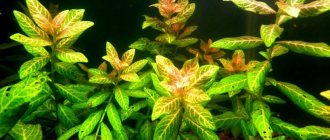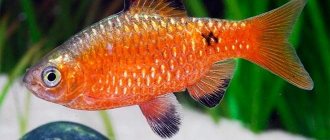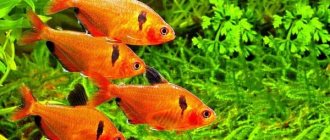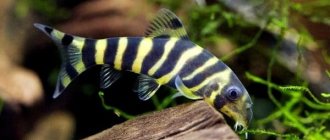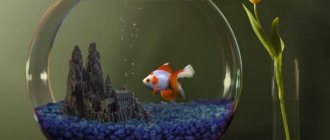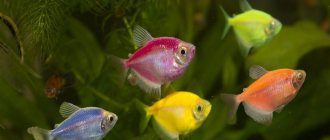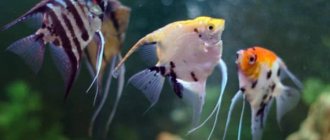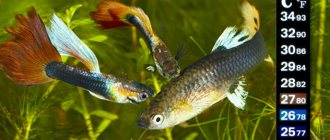Marbled botia (Botia almorhae) is a small aquarium fish that belongs to the loach family. Another name it goes by is Pakistani loach. Its homeland is located in the reservoirs of Hindustan, where the fish can reach large sizes - about 30 cm in length. It is most often found in India and Pakistan. Botia lives in bodies of water with little current, or where it is completely absent: in lakes, ponds, etc.
External characteristics
At home, the body length of the fish is about 6-7 cm, and sometimes more. In its natural habitat, the lohakat can grow up to 30 cm. The color of the marbled botia is quite unusual: its body is covered with silver-colored scales, with a slight bluish tint, and on the body and fins of the fish there are dark-colored stripes, they look irregular in shape. The body is oblong, elongated, with a small head. The fish's mouth is turned downwards, this is a distinctive feature of fish that feed from the bottom. Four pairs of whiskers can be seen at the corners of the mouth. The color of the fish may noticeably fade if it is frightened, and the fish itself may appear dead.
General description of the fish
Marbled botia is often also called lohakata. This fish was first described in 1920. People also call her “Pakistan” or “yo-yo”. This is what one American photographer called the fish, since on the side of its body there is a characteristic silver pattern reminiscent of the Latin letters Y and O.
Marbled botia belongs to the loach family, which was once mistakenly classified as a cyprinidae due to its appearance and body structure. In the wild, the Pakistani fish lives in quiet creeks, small rivers and flowing lakes in Pakistan and India.
The fish cannot be classified as a rare and endangered species, since it is not considered a commercial fish. In Russia, this pet gained popularity quite recently, but in Europe they began to breed the Pakistani dog more than 60 years ago.
It is worth noting that the classification of varieties of this fish is still quite vague. For example, individuals from Indian waters are much larger in size and brighter in color than their relatives from Pakistan. This may suggest that they may be two completely different subspecies or even species.
The Pakistani woman has an elongated body, resembling the shape of a torpedo, the back is arched, and the abdomen is straight. Thanks to powerful pectoral fins, the fish easily maneuvers in the water, even in the bottom layers of rivers and lakes. The head of the Pakistani is small in size, the mouth is located below, and four pairs of rather sensitive antennae are located nearby.
The color of the botia is silver; there are also pronounced black patterns, which become blue with age, giving the individuals a marbled tint. If a small fish is under severe stress, the color becomes pale, and in severe stressful situations, the yo-yo pretends to be dead, freezing in the belly-up position. At the same time, the body turns pale to such an extent that the predator has no doubt that a dead fish lies in front of him.
In the wild, the size of the botia reaches up to 20 cm in length. However, when grown at home in an aquarium, the fish grows only up to 7 cm. There have also been cases when an individual grew up to 15 cm in length. It is for this reason that fish of this species cannot be classified as small.
From the editor: How, what and how much to feed goldfish?
Another feature of the bots is the presence of spikes located under the eyes. The aquarium fish releases these hooks only if it senses danger approaching or notices an attempt to catch it with a net. Therefore, you need to be very careful, since the lohakata can injure itself by catching its spikes on the net.
Maintenance and care
To properly keep fish, you need to purchase an aquarium with a volume of 130 liters or more. The more spacious and larger the aquarium, the better, because, despite the small size of the bot, it is very active and mobile, and accordingly, it needs more space. Fish of this species prefer to live in the lower layers.
Another reason why you should buy a large aquarium is that marbled bots should be kept in small flocks (about 5 individuals), and a flock requires a lot of space. But you can’t keep less than 5 fish in a school, otherwise they will get stressed and start hiding.
And this type of fish loves to hide; they can often climb into rather narrow gorges, and sometimes get stuck in them. Therefore, you should not be lazy to count the fish and make sure that none of them are stuck somewhere in the crack. Since these aquarium fish like to be safe, the aquarium should be equipped with various shelters for them, preferably narrow and inaccessible.
As for water, they are very sensitive to its purity and parameters. Therefore, if the water parameters in a new aquarium do not correspond to the norm, you should not add fish to it. The aquarium should provide high-quality filtration, and old water should be replaced with new and fresh water regularly. The water temperature should be between 25-30 degrees.
There must be soil at the bottom of the aquarium (sand or small pebbles). It is important that the pebbles do not have sharp jagged edges, since fish often get rid of excess mucus by rubbing themselves on the ground. The bottom coating should be dark in color. The lighting is dim because the fish leads an active lifestyle in the evening and at night.
Botsia fish
Until a certain time, Botsiya fish were very rare in Russia, and only recently their supplies from abroad have increased. The homeland of these fish is the rivers and lakes of Southeast Asia. The diversity of species suggests a huge number of color variations.
Types of botia
Beardmore's botsia, aka tiger
One of the most beautiful fish, covered with dark oval spots and horizontal stripes along the back. Very bright, colorful fish. In daylight it prefers to hide in a shelter; the time of its activity is night. It is quite demanding on water, since in nature it lives in clean flowing waters saturated with oxygen. Does not tolerate bright light. It prefers to swim closer to the bottom, loves to hide in snags, caves, and between stones.
From the editor: Akara red-breasted
It is quite unpretentious in food and tolerates frozen food well. Since activity wakes up only at night, it is better to feed the borer in the late evening.
Chess Botsiya
Incredibly beautiful and graceful aquarium fish. It has an elongated body (up to 10 cm) with light fins with black stripes. It does not like loneliness and requires a community of relatives, so it is better to keep chess fighting dogs in groups of 6 individuals. Active during the day. Just like her tiger relative, she loves shelters, snags and caves, and dim lighting.
It was first described only in 2004, so it is rarely found in pet stores.
Botia clown
The body of the clown loach is slightly rounded, the color is yellow or orange, with three wide transverse stripes. Under natural conditions, the clown loach can grow up to 30 cm, but in an aquarium it rarely reaches such a length.
Clowns are quite demanding regarding the conditions for keeping botia: an aquarium of at least 200 liters, shelters (snags and caves) are required, dim lighting, water hardness 5-10º, pH maximum 8.0, temperature up to 30ºC. Aeration, filtration, and daily water changes are required. In addition, clown bots are susceptible to various diseases and react very strongly to care conditions. Therefore, novice aquarists are not recommended to keep this type of botia.
Bengal botia
A spectacular aquarium fish, Botsia, with nine black transverse stripes on a golden body. This botia is more relaxed about intermittent aeration than the clown botia: thanks to intestinal respiration, it does not experience oxygen starvation. But Bengal bots are just as picky about the soil and clean water as clowns. They immediately react to contamination with bacterial infections and even ulcerative processes.
Loach diseases can be successfully treated with antibiotics in the early stages.
Reticulated botia, also known as hummingbird botia
This beautiful fish with a chocolate mesh on its body prefers to stay awake during the day. Constantly on the move, absolutely not picky about food. It prefers to be in a group of its own relatives, so it is usually bought in a flock. A group of 10-15 hummingbirds looks very impressive. Unfortunately, producers of this type of fish are prone to cannibalism.
It is impossible to describe all types of fighting. Marbled, red-finned, chameleon botia, Helodes, Dario, Rostrata, etc. All species are united by an extremely active lifestyle, an inquisitive character, a peaceful attitude towards other fish and a tendency towards petty hooliganism.
The diseases of bots are caused by their tendency to gluttony: they cannot afford to miss a fat worm or an extra crumb of bread. Therefore, most often, fighting dogs suffer from obesity of internal organs. How long the fighting will live will depend on proper care and nutrition. In the absence of stress, to which these fish react very strongly, with proper nutrition and proper care, the loachfish can live for ten years.
WomanAdvice.ru>
Feeding
You can feed the marbled botia with both live and frozen food, since it is not picky about food. Feeding with dry food is not advisable, and is allowed only in extreme cases when other food is not available. Also, bots are not averse to treating themselves to young shoots of plants. To prevent the fish from eating the vegetation planted at the bottom of the aquarium, they can be given fresh cucumbers a couple of times a week, which should be pressed down on the bottom with a pebble.
Lohakata is very gluttonous, and excessive gluttony can lead to obesity. To avoid this, fish should go on a fast one day a week, depriving them of any food.
Compatibility
By nature, bots are quite peaceful, so they can get along well with other fish. However, you should not put predatory or aggressive fish in a common aquarium with them. If the fish are stressed or frightened, they will constantly hide in the shadows or in secluded places. Also, constantly being in this state can lead to the fish completely refusing to feed. In a school of these fish, a certain hierarchy is established between males. The dominant male may engage in small skirmishes. But such conflicts do not cause much harm or damage to fish.
Excellent neighbors for marble bots will be clown bots or other bindweeds.
Reproduction and breeding
It is very difficult to breed bots at home, but it is possible. First you need to make a spawning tank (a reservoir in which the female will spawn) and equip it. An aquarium with a volume of 100-150 liters should be used as such a reservoir for spawning. No soil is needed for the spawning tank; instead, you need to put a net on the bottom. Place shelters in the form of stones and driftwood here. To create natural conditions, a current should be created in the spawning tank (a filter and pumps are used for this).
The water temperature of the spawning tank should be several degrees higher than in a regular aquarium. To stimulate the start of spawning, you need to add a small amount of fresh, new water. A pair of mature and young fish is introduced into the prepared tank. During this period, they need to be fed in larger quantities than usual; live food (bloodworms or tubifex) is used as food. After some time, spawning begins: first, the male circles around the female, then turns over, picks her up and spawning occurs near the surface of the water. When the eggs are laid, the parents should be removed from the spawning area into a community aquarium. Otherwise, producers may eat the eggs or fry.
The female can lay up to 5,000 eggs in one spawning. They are small in size and have a grayish-green tint. After 16-18 hours, fry will emerge from them. In the first 4 days they will not be able to swim independently and feed on reserves from the yolk sac. Then they need to start feeding them zooplankton or rotifers.
Diseases
How long do warriors live? Under good and high-quality conditions, they can live up to 5-8 years. But there are exceptions when fish live up to 16 years. However, the life expectancy of a lohakata can be significantly reduced if certain diseases are not prevented in time. Let's look at the diseases that marbled botia can get.
- Ichthyophthiriasis is a disease characterized by small white bumps that resemble semolina. Another name for this disease is “semolina”. The source of this disease is ciliates; it can be brought in with low-quality food.
When the disease is detected, the water temperature should be increased a few degrees. If the disease is at an advanced stage, consult a specialist.
- Stress - can be caused by a change in situation or environment. Because of this, the fighting can rush from side to side. To avoid this, fish should be introduced into a new aquarium with the lights turned off. Then in the dark it will be easier for them to adapt to new conditions and explore their environment.
- Weight loss – The cause of weight loss is considered to be the occurrence of flagellated parasites of the genus Spironucleus. To cure this disease, the fish should undergo a course of treatment with antibiotics such as Levamisole and Panacur.
Diseases
Marbled bots are not resistant to diseases. Of the entire community aquarium, only the bots can get sick, while the rest of the fish are feeling normal. They do not tolerate copper sulfate and malachite greens.
Ichthyophthiriasis (“semolina”). Damage by ciliate parasites. Introduced by new inhabitants, with low-quality food. Appears in the form of white tubercles on the scales. Treating it yourself is risky. Contact an ichthyopathologist.
Bacterial infection of scratches. Manifest in the form of ulcers, inflammations, spots. Treat with Sera Baktopur, Sera Baktopur direct, Ektol, Tsifran according to the attached instructions.
Diplostomatosis (helminthic cataract). Parasitic damage to the eye by larvae of digenetic flukes. Symptoms: clouding and swelling of the eye. Spread by shellfish and objects from natural bodies of water. Contact an ichthyopathologist.
Carp rubella. Bacterial or viral infection. Symptoms resemble nitrate poisoning. Perform ammonia and nitrate tests. Red spots (hemorrhages) on the body, bulging eyes, dropsy, ulcers. Treated with interferon from a pharmacy (1 ampoule per 30–40 liters of water) together with Sera Baktopur direct. The biofilter will not work due to medications.
Disease prevention: any addition to the aquarium goes through a 40-60 day quarantine. Quarantine aquarium with a volume of 60–80 liters with its own equipment.
